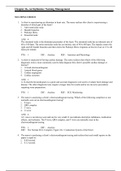Business Study guides, Class notes & Summaries
Looking for the best study guides, study notes and summaries about Business? On this page you'll find 83 study documents about Business.
Page 4 out of 83 results
Sort by
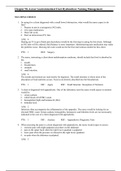
-
Chapter 50--Lower Gastrointestinal Tract Dysfunction: Nursing Management
- Exam (elaborations) • 6 pages • 2020
-
- $6.49
- + learn more
Chapter 50--Lower Gastrointestinal Tract Dysfunction: Nursing Management MULTIPLE CHOICE 1. In caring for a client diagnosed with a small bowel obstruction, what would the nurse expect to do first? 1. Prepare to put in a nasogastric (NG) tube. 2. Give pain medication. 3. Draw lab work. 4. Start an intravenous (IV) line. PTS: 1 REF: Surgery 2. The nurse, instructing a client about malabsorption syndrome, should include that food is absorbed in the: 1. mouth. 2. bloodstream. 3. stomach. 4. small i...
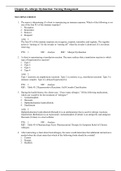
-
Chapter 43--Allergic Dysfunction: Nursing Management
- Exam (elaborations) • 6 pages • 2020
-
- $6.49
- + learn more
Chapter 43--Allergic Dysfunction: Nursing Management MULTIPLE CHOICE 1. The nurse is determining if a client is experiencing an immune response. Which of the following is not one of the four R’s of the immune response? 1. Recognize 2. Remember 3. Remove 4. Respond PTS: 1 DIF: Analyze REF: Allergic Dysfunction 2. A client is experiencing a transfusion reaction. The nurse realizes that a transfusion reaction is which type of hypersensitive reaction? 1. Type 1 2. Type 2 3. Type 3 4. Type 4 ANS: 2...
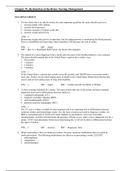
-
Chapter 35--Dysfunction of the Brain: Nursing Management
- Exam (elaborations) • 6 pages • 2020
-
- $6.49
- + learn more
Chapter 35--Dysfunction of the Brain: Nursing Management MULTIPLE CHOICE 1. For the client who is at risk for stroke, the most important guideline the nurse should teach is to: 1. increase drinks with caffeine. 2. monitor blood pressure. 3. increase amounts of sodium in the diet. 4. monitor weight and activity. PTS: 1 DIF: Apply REF: Box 35-1 Modifiable Risk Factors for Stroke Development 2. The family of a client diagnosed with a stroke asks the nurse if this health problem is very common. The...
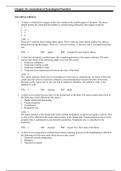
-
-Assessment of Neurological Function
- Exam (elaborations) • 6 pages • 2020
-
- $6.49
- + learn more
Chapter 34--Assessment of Neurological Function MULTIPLE CHOICE 1. A client is scheduled for surgery to fuse the vertebra in the lumbar region of the spine. The nurse should instruct the client that the number of vertebra being affected by this surgery would be: 1. 7. 2. 12. 3. 5. 4. 4. PTS: 1 DIF: Apply REF: Central Nervous System: Bones 2. A client has sustained a cerebral injury that is applying pressure to the corpus callosum. The nurse realizes that which of the following might occur with ...
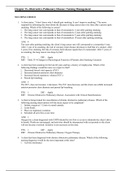
-
Chapter 33--Obstructive Pulmonary Disease: Nursing Management
- Exam (elaborations) • 6 pages • 2020
-
- $7.49
- + learn more
Chapter 33--Obstructive Pulmonary Disease: Nursing Management MULTIPLE CHOICE 1. A client states, “I don’t know why I should quit smoking. It can’t improve anything.” The nurse responds by informing the client about the decrease in lung cancer rates over time after a person quits smoking. Which of the following is correct? 1. The lung cancer rate corresponds to that of nonsmokers 1 year after quitting smoking. 2. The lung cancer rate corresponds to that of nonsmokers 2 years after quitti...
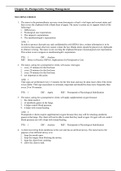
-
Chapter 22--Postoperative Nursing Management
- Exam (elaborations) • 6 pages • 2020
-
- $7.49
- + learn more
Chapter 22--Postoperative Nursing Management MULTIPLE CHOICE 1. The nurse in the postanesthesia recovery room documents a client’s vital signs and current status and then covers the clipboard with a blank sheet of paper. The nurse’s actions are to support which of the following? 1. HIPAA laws 2. Postsurgical care expectations 3. The surgeon’s expectations 4. The anesthesiologist’s expectations PTS: 1 DIF: Analyze REF: Ethics in Practice: HIPAA: Implications for Perioperative Care 2. The...
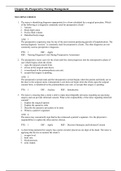
-
Chapter 20--Preoperative Nursing Management
- Exam (elaborations) • 6 pages • 2020
-
- $7.49
- + learn more
Chapter 20--Preoperative Nursing Management MULTIPLE CHOICE 1. The nurse is identifying diagnoses appropriate for a client scheduled for a surgical procedure. Which of the following is a diagnosis commonly used for preoperative client? 1. Anxiety 2. Sleep deprivation 3. Excess fluid volume 4. Disturbed body image PTS: 1 DIF: Apply REF: Nursing Diagnoses Used During Preoperative Assessment 2. The preoperative nurse cares for the client until the client progresses into the intraoperative phase of...
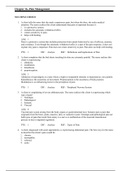
-
Chapter 16--Pain Management
- Exam (elaborations) • 6 pages • 2020
-
- $7.49
- + learn more
Chapter 16--Pain Management MULTIPLE CHOICE 1. A client tells the nurse that she rarely experiences pain, but when she does, she seeks medical attention. The nurse realizes this client understands that pain is important because it: 1. is a protective system. 2. includes the automatic withdrawal reflex. 3. creates sensitivity to pain. 4. helps with healing. PTS: 1 DIF: Analyze REF: Definitions and Implications of Pain 2. A client complains that the bed sheets touching his skin are extremely pain...
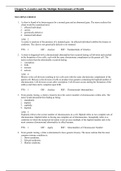
-
Chapter 9--Genetics and the Multiple Determinants of Health
- Exam (elaborations) • 6 pages • 2020
-
- $7.49
- + learn more
Chapter 9--Genetics and the Multiple Determinants of Health MULTIPLE CHOICE 1. A client is found to be heterozygous for a normal gene and an abnormal gene. The nurse realizes this client would be considered a(n): 1. affected individual. 2. carrier. 3. genetically defective. 4. mutated individual. PTS: 1 DIF: Analyze REF: Fundamentals of Genetics 2. A client is diagnosed with a chromosomal abnormality that occurred during cell division and resulted in the formation of two cells, each with the sa...

How did he do that? By selling his study resources on Stuvia. Try it yourself! Discover all about earning on Stuvia

